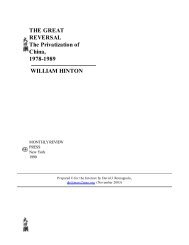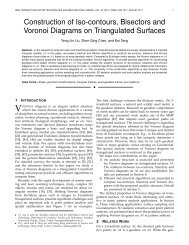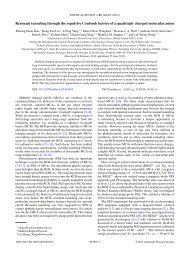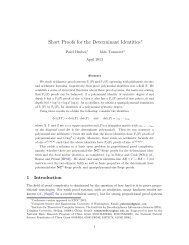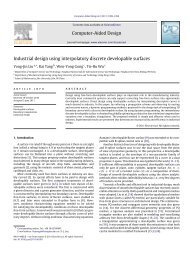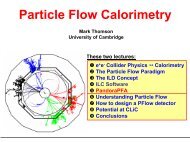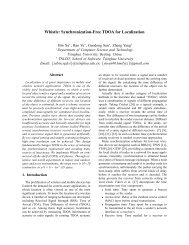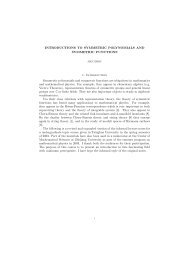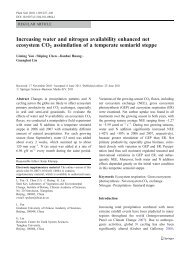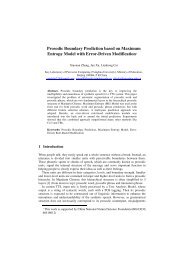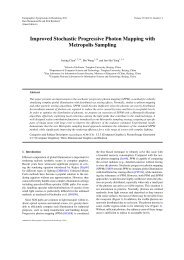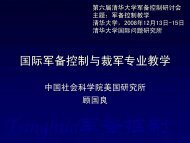Feature Preserving Mesh Simplification Using Feature Sensitive Metric
Feature Preserving Mesh Simplification Using Feature Sensitive Metric
Feature Preserving Mesh Simplification Using Feature Sensitive Metric
You also want an ePaper? Increase the reach of your titles
YUMPU automatically turns print PDFs into web optimized ePapers that Google loves.
596 J. Comput. Sci. & Technol., May 2010, Vol.25, No.3<br />
of image manifold [6] , Lai et al. [7] map each point in R 3<br />
into a six-dimensional image with a non-negative w indicating<br />
feature sensitivity, so that a point in FS space<br />
will be in the form of (p, wn). [8] also proves that<br />
the area size in FS space is directly related to the local<br />
curvature properties. In addition, mapping to FS space<br />
could produce a blow-up phenomenon at sharp features<br />
such as creases and corners according to the user requirements.<br />
Detected feature lines will be expanded to<br />
the surface area in R 6 to adjust the mesh density in FS<br />
space. Thus, using FS metric, it can naturally increase<br />
the quality in feature regions, without the necessity of<br />
explicitly detecting sharp features (Fig.1). The usefulness<br />
of FS metric has been demonstrated in the applications<br />
of remeshing [7] , mesh segmentation [9] , surface<br />
fitting [8] , and feature extraction and classification [7] .<br />
Fig.1. Distance isolines in feature sensitive space (this figure is<br />
from [7]).<br />
In this paper, we present a novel mesh simplification<br />
based on a feature sensitive metric, for efficiently<br />
simplifying polygonal meshes with a new quadric error<br />
function defined in feature sensitive space. This<br />
method extends classical QEM to a constraint highdimensional<br />
space with specific rule for singular situations.<br />
Experimental results demonstrated that our<br />
approach can naturally allocates more patches to the<br />
feature regions, without complicated procedure for feature<br />
detection. We also proposed a weight scheme to<br />
resemble the blow-up phenomenon that is described in<br />
[8]. With the proper preferences, this algorithm will<br />
strongly improve the visualization quality with lower<br />
Hausdorff distances.<br />
In Section 2 we review the previous work about mesh<br />
simplification, and describe their differentia to our algorithm.<br />
Then the new scheme for our FS mesh is discussed<br />
in Section 3. Section 4 presents the optimization<br />
method to preserve singular situations at boundaries<br />
and blow-up. Experimental results are shown in Section<br />
5 and the conclusions and remarks on future work<br />
are given in Section 6.<br />
2 Related Work<br />
To preserve features during the simplification, we<br />
have chosen to design a pair-contraction based method.<br />
The main issue then becomes to define cost priority<br />
and selection of optimizing target position that produce<br />
minimum error.<br />
• QEM<br />
Garland and Heckbert [2] defined the error metric as<br />
the sum of squared distance from a given point to its<br />
corresponding plane. This can be easily converted into<br />
a quadrics matrix form. Therefore the error function<br />
was constructed as: η(v) = v T Qv. Positions that have<br />
the smallest η(v) then become contraction target point<br />
for a pair. In addition, η(v) should be sorted ascending<br />
into a heap so as to determine the contraction order.<br />
• <strong>Preserving</strong> <strong>Feature</strong>s<br />
QEM method can preserve position information well<br />
with efficiency than the previous simplification method.<br />
However, the error metric of QEM is based only on positions<br />
but not for the curvature or the variation of<br />
Fig.2. Horse model (10024 tri. to 596 tri.) with green (or red) colored feature region. (a) Input mesh. (b) QSlim result. (c)∼(d) Our<br />
FS method without and with blow-up. The corresponding zoom in viewer are under them, ω = 0.03. Obviously (c) produces more<br />
reasonable result than (b), and (d) preserves more detail for the head rather than retain the triangles on the leg and joints.



